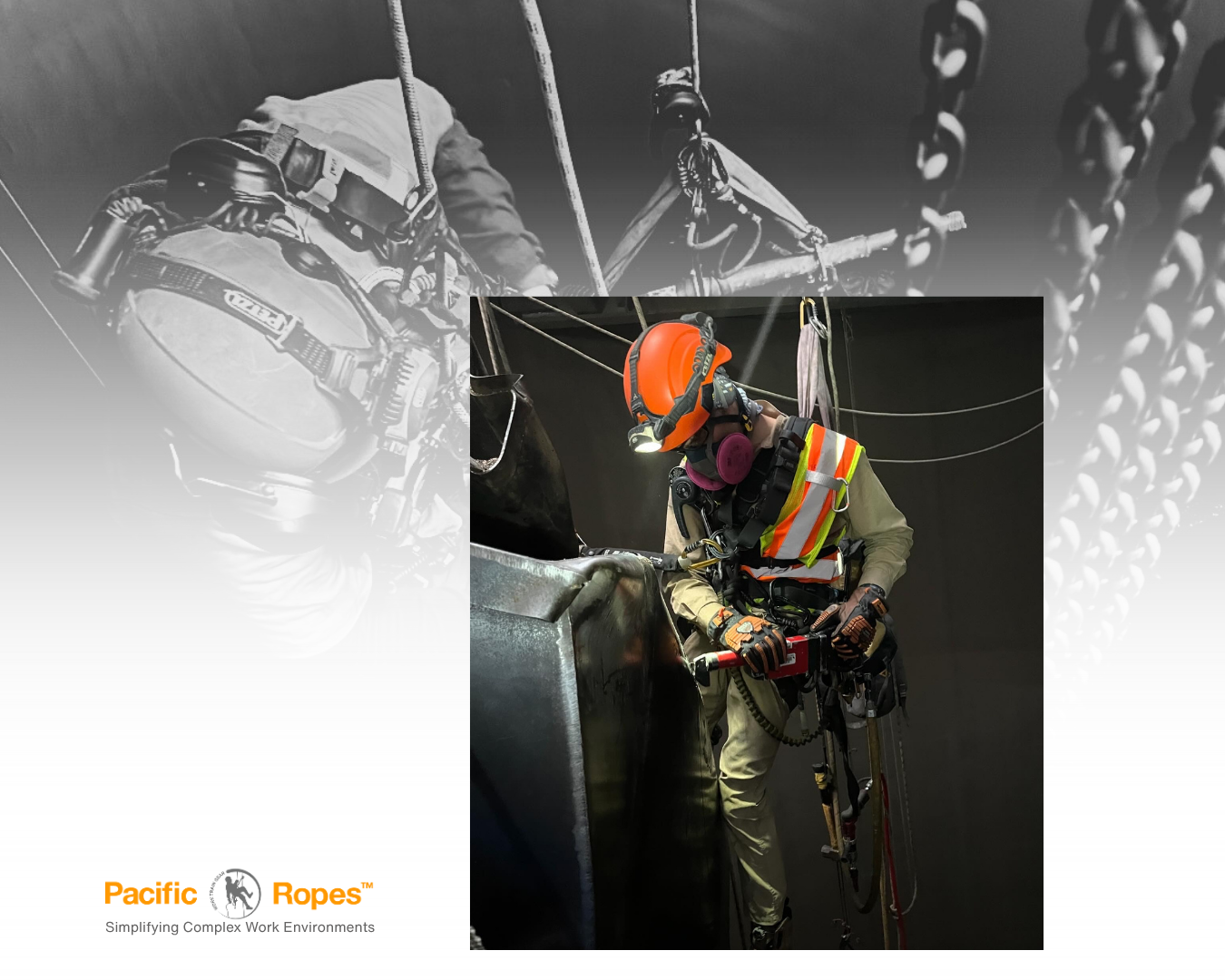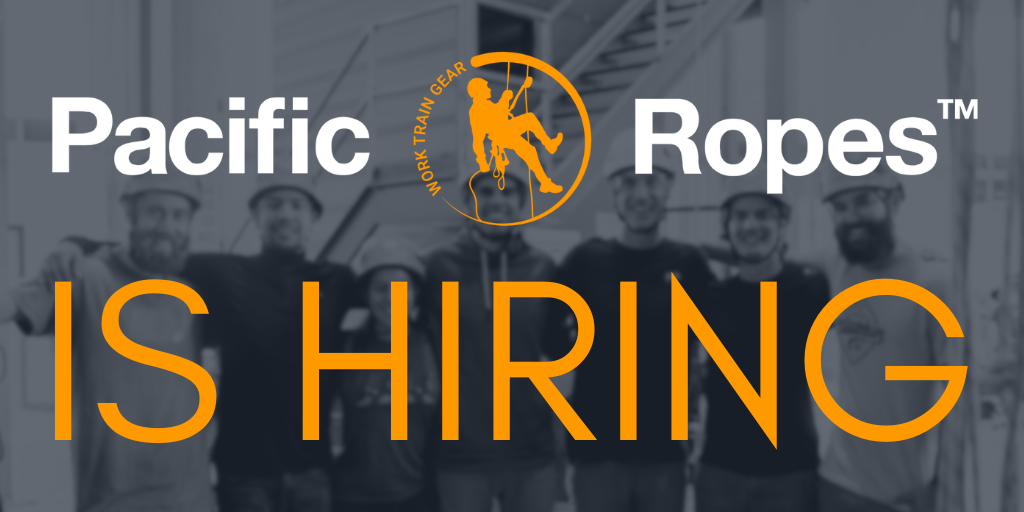If your work involves inspections, repairs, or maintenance at height, you’ve probably dealt with scaffolding or lifts. But there’s another method that’s rapidly gaining traction in industrial sectors: rope access.
Originally developed for offshore oil rigs, rope access is now one of the most trusted ways to reach difficult areas safely, efficiently, and with minimal disruption.
What is Rope Access?
Rope access is a system of work positioning that uses ropes, harnesses, and anchors to allow technicians to safely access vertical or hard-to-reach environments. It’s used for everything from structural inspections and welding to cleaning and coating, all without the need for scaffolding or heavy machinery. Hard-to-reach environments may include environmental factors (such as above water), or engineering constraints (confined spaces, irregular structures), time factors (requirements for quick access to eliminate assembly/disassembly of access equipment), and work at height (bridges, building exteriors).
Technicians are suspended in harnesses and use a combination of ascent, descent, and positioning techniques to get precisely where the work is, and stay secure while doing it.

Where Did Rope Access Come From?
Rope access originated in the 1980s in the offshore oil and gas industry, where space was limited and structures were complex. Traditional access methods like scaffolding simply weren’t practical for flare stacks or platform legs in open water.
Using climbing and caving techniques, technicians began moving efficiently across these structures using rope-based systems. Over time, these methods became formalized, giving rise to international certification bodies like IRATA (Industrial Rope Access Trade Association).
Where Is Rope Access Used Today?
Rope access is now standard in a wide range of industries:
Civil Infrastructure and Power Generation
- Bridgework
- Dams
- Inspections
- Wind turbines
.png?width=908&height=908&name=Blog%20Image%20Wind%20Turbine%20%20(1).png)
Facilities and Construction
- Maintenance
- Window cleaning
- Painting
- Glazing
- Scaling
- Sign installations

Oil & Gas
-
Flare stacks
-
pipe racks,
-
offshore platform

Heavy Industry and Mining
- Conveyor systems
- Tanks
- Silos

Why Choose Rope Access? Key Benefits
- Faster setup and teardown — compared to scaffolding
- Minimal site disruption — ideal for live plants or remote locations
- Lower total cost — reduced labor, fewer delays, less equipment
- Adaptable — works in confined spaces, on verticals, or in hard-to-reach areas
- Environmentally low-impact — no heavy machinery or staging required
Rope Access is Efficient and Economical
Rope Access can alleviate a lot of the complexities that comes with completion dates and project timelines. Due to the nature of how rope access works - with the technician equipped with tools and materials in their work position/location, there is less reliance on significant external factors and materials to complete or support the projects. This results in more time spent on the project, rather than assembling/dissembling supporting materials to gain access.
In other circumstances, because a Rope Access Technician requires a smaller footprint to work, other trades or work can also be completed simultaneously near or around the work location. This inevitably speeds up the timeline for projects or allows for businesses to remain open during work hours instead of forced closures due to lack of access and/or unsafe conditions, resulting in lost revenue. Results from this Case Study demonstrates how Ropes Access reduced time and cost for our client.
A Smaller Environmental Footprint
Similarly to the reason what makes Rope Access more efficient, having less reliance on other materials means Rope Access does not rely nearly as much on the transportation of goods and materials to and from locations, which has an impact on the environment. Less trucks for delivery of support systems, assembling and disassembling them also means there are less emissions. In addition, remote locations are often in environmentally sensitive areas, and difficult to reach. A logistical challenge alone when considering more equipment, but also requiring less materials means less disturbance to the surrounding areas.
Versatility is Key
Think of Rope Access as a multi tool. Projects of all sizes will inevitably have challenges due to a variety of factors. Rope Access has the ability to filter out the noise, despite the scale of the challenge, to complete the job, or to support other trades in completing their tasks. Accessibility to work locations and finding innovative solutions is our objective. Collaboration with clients to find these solutions is where we thrive.
How Is Rope Access Safe?
Rope access has one of the best safety records in the work-at-height industry. This is largely due to:
-
Redundant safety systems (dual rope setups)
-
Comprehensive technician training (minimum 1,000+ hours to reach IRATA Level 3)
-
Regular equipment inspections and rescue protocols
-
Strict job site procedures and oversight
IRATA-certified technicians follow globally recognized safety standards on every job.
This industry has a vigorous and intense process to ensure that all technicians are constantly assessing, aware, and attentive to details. Starting with the thorough training process, to logging hours at the technician level, and also having regulatory bodies such as IRATA to objectively assess and evaluate technicians, as well as having mandatory requirements for businesses to comply with safety measures, this industry is all about redundant safety.
Learn More: Rope Access vs. Scaffolding
Curious how rope access compares directly to scaffolding or lifts? Check out our new blog:
Why Rope Access Is the Smart Alternative to Scaffolding
Find out more about Rope Access, and how we can collaborate to find solutions to your current or potential access challenges. Schedule a Discovery Call for any questions you have about how to incorporate Rope Access into your work scope!



